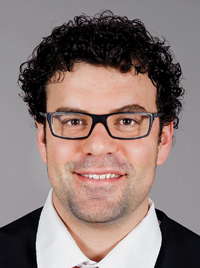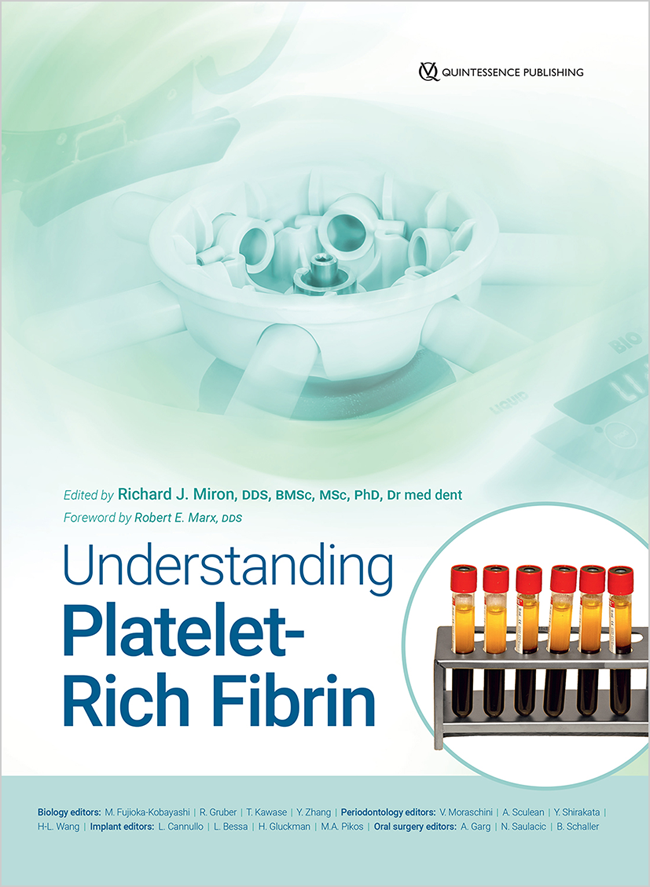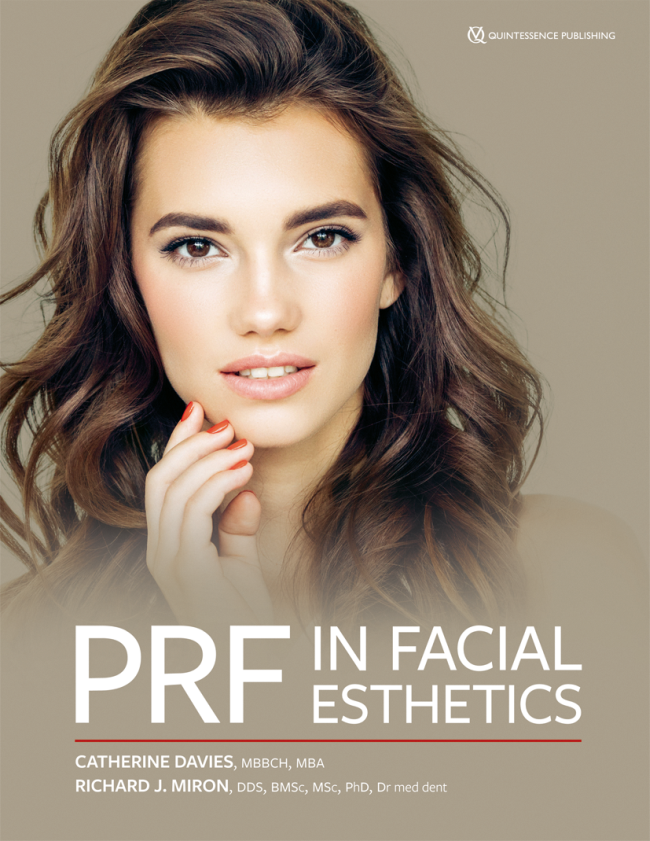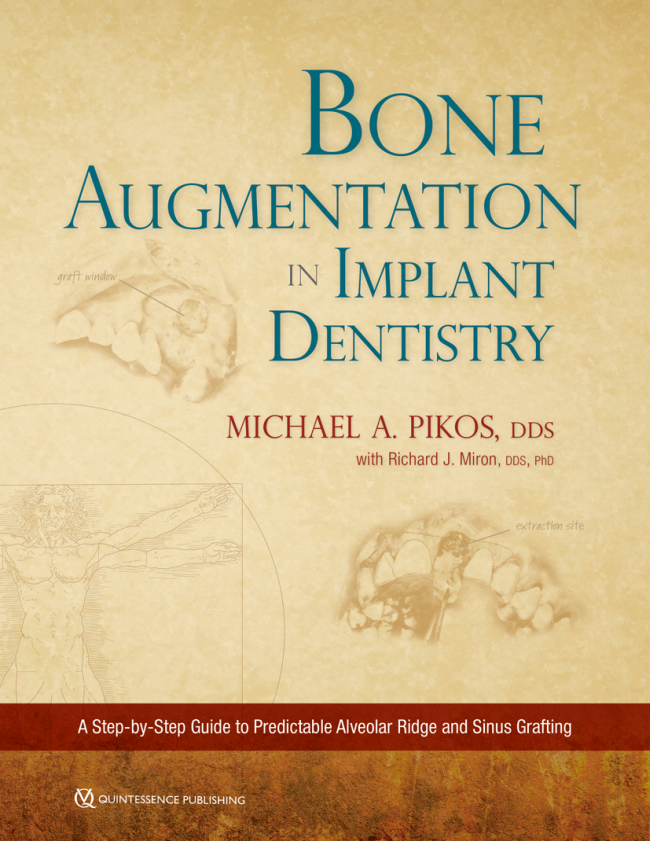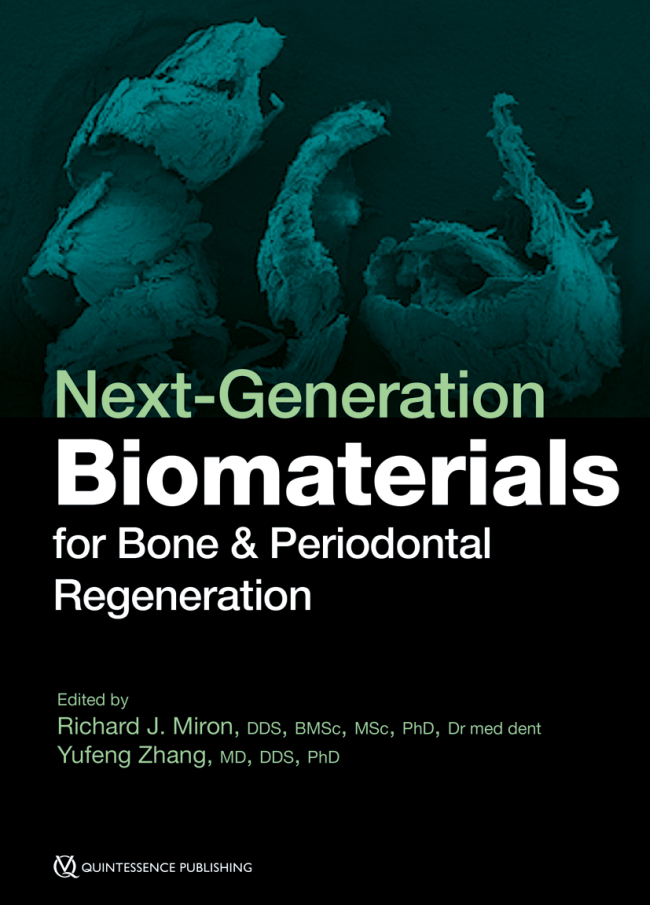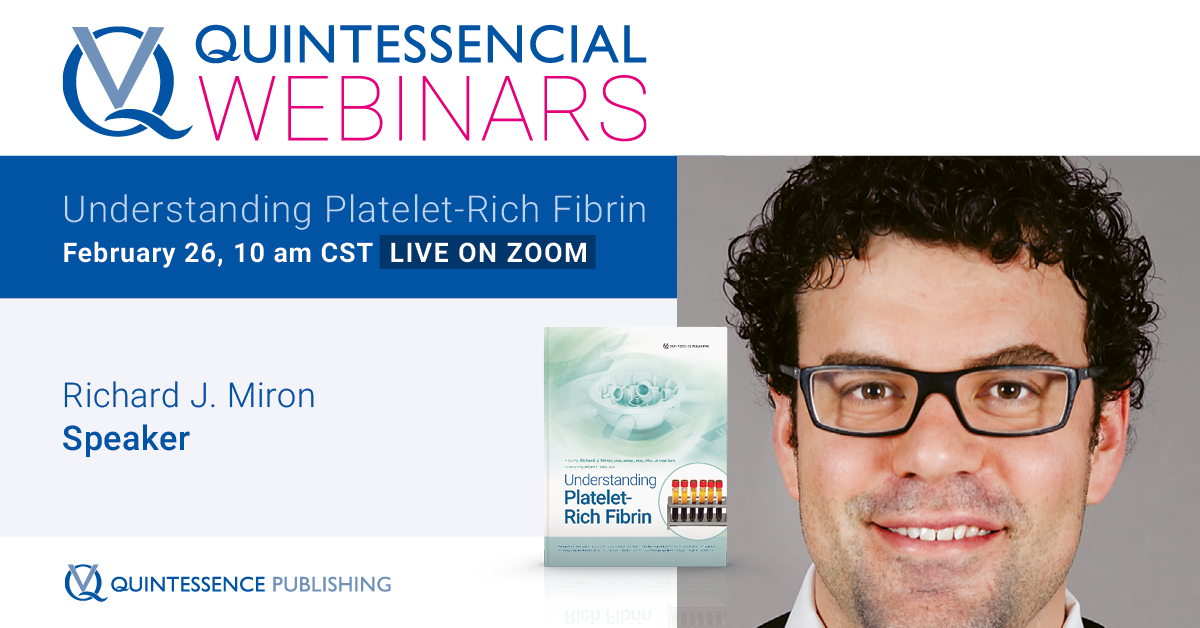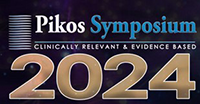International Journal of Periodontics & Restorative Dentistry, Pre-Print
DOI: 10.11607/prd.7567, PubMed-ID: 40053497März 7, 2025,Seiten: 1-20, Sprache: EnglischEstrin, Nathan / Farshidfar, Nima / Ahmad, Paras / Froum, Scott / Castro Pinto, Marco Antonio / Zhang, Yufeng / Miron, Richard J.Exosomes, the smallest subset of extracellular vesicles, play a crucial role in cell signaling and communication throughout the body. Their regenerative potential has sparked tremendous interest, with over 5,000 articles on exosomes being published yearly, primarily focused on invitro and pre-clinical studies. However, to date, no study has investigated their use in humans for dental applications. In this first case report, horizontal ridge augmentation was performed utilizing a novel combination of bone allografts, platelet-rich fibrin (PRF), and a specialized subset of exosomes (Periosomes). Implants were placed at 3 months post-surgery, during which a core biopsy was taken for histological analysis. Additionally, cone-beam computed tomography (CBCT) scans were obtained at 1, 2, 3, and 6 months, revealing marked and progressive bone growth. To our knowledge, this study represents the first documented use of exosomes in human alveolar bone regeneration. This case highlights the promising potential of exosomes in regenerative dentistry, opening new avenues for their application in guided bone regeneration procedures.
Schlagwörter: Alveolar ridge augmentation, Guided tissue regeneration, Leukocyte and Plateletrich fibrin, Exosomes, extracellular vesicles, bone morphogenetic protein
International Journal of Periodontics & Restorative Dentistry, 1/2024
DOI: 10.11607/prd.6441, PubMed-ID: 37677137Seiten: 51-57, Sprache: EnglischPikos, Michael A. / Miron, Richard J.The ability for clinicians to adequately obtain primary stability in host bone is critical to the success of dental implants. Numerous conditions require dentists to perform multistage approaches to rebuild deficient bone volume prior to surgically placing implants. In many instances, implant placement cannot be achieved due to a lack of primary implant stability. Recently, a novel mineral-organic resorbable bone adhesive (MORBA) has demonstrated promising results in animal studies. MORBA is a synthetic, injectable, self-setting, load-bearing adhesive biomaterial that exhibits osteopromotive properties and bonds bone to bone and metal within 10 minutes and can fully resorb in 30 weeks. Its unique novel formulation was developed from biomimetic proteins found in marine animal creatures that possess distinct adhesive properties underwater. Excellent long-term results have shown its potential use for achieving primary stability in immediate implants. The present case report demonstrates the first use of MORBA in a human patient, utilized on a nonrestorable mandibular first molar. MORBA was utilized after placement of a mobile 5.8-mm implant to achieve stabilization. At 3 months postsurgery, both clinical and CBCT evaluations showed maintained implant stability. One year after implant placement, radiographic bone was seen on the buccal surface of the implant with continued long-term stabilization. This case report extends to 3 years whereby the use of MORBA, in an initially unstable situation, demonstrated an excellent long-term follow-up. MORBA provided immediate implant stability with resorbable characteristics, leading to successful long-term clinical outcomes up to 3 years. This innovative biomaterial offers a more efficient solution to a critical problem in implant dentistry, allowing optimal primary stability during immediate implant placement, thus reducing treatment times and costs.
International Journal of Periodontics & Restorative Dentistry, 4/2023
DOI: 10.11607/prd.5859, PubMed-ID: 37552191Seiten: 443-449, Sprache: EnglischBishara, Mark / Sinada, Naif / Wu, David T. / Miron, Richard J. / Karateew, Dwayne / Gluckman, Howard / Salama, MauricePartial extraction therapy (PET) is a set of surgical techniques that preserve a portion of the patient’s own root structure to maintain blood supply derived from the periodontal ligament complex in order to maintain the periodontium and peri-implant tissues during restorative and implant therapy. PET includes the socket shield technique (SST), proximal shield technique (PrST), pontic shield technique (PtST), and root submergence technique (RST). In a traditional hybrid technique, total extraction and full-arch dental implant therapy often require significant bone reduction and palatal/lingual implant placement. In addition, postextraction preservation of the ridge architecture is a major challenge. This case series demonstrates the use of a combination of PET techniques with digital implant planning and guided implant surgery to achieve highly esthetic outcomes in full-arch implant therapy.
Oral Health and Preventive Dentistry, 1/2022
Open Access Online OnlyNarrative ReviewDOI: 10.3290/j.ohpd.b3630405, PubMed-ID: 36448277November 30, 2022,Seiten: 485-499, Sprache: EnglischEstrin, Nathan E. / Romanos, Georgios E. / Tatch, Walter / Pikos, Michael / Miron, Richard J.Summary: Most available antiseptic solutions have strong antibacterial effects, but many also possess major cytotoxic effects on gingival fibroblasts, osteoblasts, osteoprogenitor cells, and/or epithelial cells. A novel VEGA Oral Care Recovery Kit (StellaLife) consisting of 16 active ingredients that are monographed in the Homeopathic Pharmacopeia of the United States (HPUS) has gained tremendous momentum as a replacement for more cytotoxic oral rinses such as chlorhexidine. While accumulating evidence has thus far supported its use, little of the gathered data have fully described the properties of the oral formulation. Therefore, the aim of the present review article was 3-fold. First, a biological characterization regarding the active ingredients found in StellaLife Recovery Kit including their biological properties was assessed in 4 predominant categories; 1) antimicrobial resistance, 2) accelerated wound healing, 3) pain management control, and 4) anti-cancer properties. The second aim of this review article was to assess both fundamental and clinical research to date comparing VEGA oral rinse (StellaLife) to the more commonly utilized CHX for differences regarding their effect on decreasing bacterial loads as well as cell viability, survival, proliferation, and expression of both regenerative cytokines and inflammatory markers. Lastly, clinical case examples are presented describing the use of StellaLife remedies in a variety of clinical situations. These include but are not limited to wisdom-tooth extraction, extraction site management, dental implants and ridge augmentation, soft-tissue grafting procedures, frenectomies, and also temporary relief of dry sockets, dry mouth, aphthous ulcers, mucositis, lichen planus, among others. In summary, findings from the present review article provide evidence from basic laboratory experiments that validate clinical studies supporting the use of the StellaLife oral rinse regarding its superior biocompatibility and wound healing properties when compared to common antiseptic solutions such as CHX.
Schlagwörter: antiseptic solution, cell viability, chlorhexidine, oral rinses, periodontal disease, StellaLife, wound healing
Oral Health and Preventive Dentistry, 1/2022
Open Access Online OnlySystematic ReviewDOI: 10.3290/j.ohpd.b3125655, PubMed-ID: 35695693Juni 13, 2022,Seiten: 233-242, Sprache: EnglischEstrin, Nathan E. / Moraschini, Vittorio / Zhang, Yufeng / Miron, Richard J.Purpose: The aim of the present systematic review with meta-analysis was to investigate the clinical effectiveness of EMD (enamel matrix derivative) using a minimally invasive surgical technique (MIST) or flapless approach for the treatment of severe periodontal probing depths.
Materials and Methods: A systematic review of the literature including searches in PubMed/Medline, Cochrane Library, Google Scholar, and Grey Literature databases as well as manual searches was performed on September 1st, 2021. Studies utilising EMD in a non-surgical or minimally invasive approach were included. The eligibility criteria comprised randomised controlled trials (RCTs) comparing minimally-invasive/flapless approaches with/without EMD for the treatment of probing depths >5 mm.
Results: From 1525 initial articles, 7 RCTs were included and 12 case series discussed. Three studies investigated a MIST approach, whereas 3 studies utilised a flapless approach. One study compared EMD with either a MIST or a flapless approach. The RCTs included ranged from 19–49 patients with at least 6 months of follow-up. While 5 of the studies included smokers, patients smoking >20 cigarettes/day were excluded from the study. The meta-analysis revealed that EMD with MIST improved recession coverage (REC) and bone fill (BF) when compared to MIST without EMD. However, no difference in CAL or PD was observed between MIST + EMD vs MIST without EMD. No statistically significant advantage was found for employing the EMD via the flapless approach.
Conclusions: Implementing EMD in MIST procedures displayed statistically significant improvement in REC and BF when compared to MIST alone. These findings suggest that MIST in combination with EMD led to improved clinical outcomes while EMD employed in nonsurgical flapless therapy yielded no clinical benefits when compared to nonsurgical therapy alone without EMD. More research is needed to substantiate these findings.
Schlagwörter: EMD, enamel matrix derivative, enamel matrix proteins, intrabony defect, minimally invasive surgery
Quintessence International, 7/2021
DOI: 10.3290/j.qi.b1098307, PubMed-ID: 33749221Seiten: 576-582, Sprache: EnglischSculean, Anton / Allen, Edward P. / Katsaros, Christos / Stähli, Alexandra / Miron, Richard J. / Deppe, Herbert / Cosgarea, RalucaObjectives: To describe the step-by-step procedure of a novel surgical technique consisting of a combination of the laterally closed tunnel (LCT) and the modified coronally advanced tunnel (MCAT) (ie, LCT/MCAT), designed to treat multiple mandibular adjacent gingival recessions (MAGR) and to present the clinical outcomes obtained in 11 consecutively treated patients.
Method and materials: Eleven systemically and periodontally healthy patients (7 females, mean ± SD 33.62 ± 14.6 years, min. 19 years max. 67 years) with a total of 40 adjacent mandibular RT1 (ie, Miller Class 1 and 2) gingival recessions with a minimum depth ≥ 3 mm, were consecutively treated with LCT/MCAT, in conjunction with an enamel matrix derivative (EMD) and subepithelial palatal connective tissue graft (SCTG). Treatment outcomes were assessed at baseline and at 12 months postoperatively. Prior to surgery and at 12 months postoperatively, recession depth (RD) and recession width (RW) were evaluated. The primary outcome variable was complete root coverage (CRC, ie 100% root coverage), the secondary outcome was mean root coverage (MRC).
Results: Postoperative pain and discomfort were low and the healing was uneventful in all cases without any complications. At 12 months, statistically significant (P < .05) root coverage (RC) was obtained in all patients. CRC was obtained in five patients with a total of 21 recessions, while MRC measured 92.9% (ie, 3.75 mm). In seven patients (ie, 63.6%), RC amounted to > 93% while the minimum RC per patient measured 83.76%.
Conclusion: The results of the present case series suggest that the LCT/MCAT is a valuable technique for the treatment of mandibular RT1 MAGR.
Schlagwörter: laterally closed tunnel, modified coronally advanced tunnel, multiple adjacent mandibular gingival recessions, recession coverage, subepithelial palatal connective tissue graft, surgical technique
Oral Health and Preventive Dentistry, 1/2021
Open Access Online OnlyOral MedicineDOI: 10.3290/j.ohpd.b2082063, PubMed-ID: 34585875September 30, 2021,Seiten: 495-502, Sprache: EnglischPaz, Ana / Stanley, Miguel / Mangano, Francesco Guido / Miron, Richard J.Purpose: Accumulating evidence has shown that vitamin D deficiency has been linked with an up to 300% increase in early implant failure. The aim of this study was to investigate a comprehensive pre-surgical dental support program (DentaMedica) on its ability to increase vitamin D and antioxidant levels prior to implant surgery.
Materials and Methods: Twenty patients were enrolled in this study. To quantify vitamin D levels, two in-office vitamin D finger-prick tests (10–15 min in length) were compared to levels obtained from a standard laboratory blood test. An antioxidant testing device was also utilised to investigate the impact of this pre-surgical supplementation program on antioxidant scores 0 and 6 weeks post supplementation.
Results: It was first found that 65% of the population had an initial vitamin D deficiency (below 30 ug/ml). After supplementation, vitamin D levels increased from an average of 24.76 ng/ml to 50.11 ng/ml (ranging from 38 to 85.50 ng/ml). No statsitcally significant differences were observed between any of the 3 testing devices (2 in-office finger-prick tests and a standard blood sample). Initial antioxidant levels registered on the biophotonic unit averaged an antioxidant score of 27250 ± 10992.22. Following supplementation, an increase of 54% from baseline values (41950 ± 9276.31) was reported.
Conclusion: The results from this study show convincingly that the majority of the tested population was vitamin D deficient. It was further found that both in-office finger-prick devices demonstrated results comparable to standard lab scores (usually within an average 2–3 ng/ml). Following supplementation, all patients reached sufficient levels following this 4–6 week pre-surgical supplementation program specific to implant dentistry.
Schlagwörter: DentaMedica, early implant failure, implant integration, osseointegration, vitamin D deficiency
Oral Health and Preventive Dentistry, 1/2021
Open Access Online OnlyPeriodontologyDOI: 10.3290/j.ohpd.b2182985, PubMed-ID: 34673845Oktober 22, 2021,Seiten: 537-546, Sprache: EnglischShirakata, Yoshinori / Sena, Kotaro / Nakamura, Toshiaki / Shinohara, Yukiya / Imafuji, Takatomo / Setoguchi, Fumiaki / Noguchi, Kazuyuki / Kawase, Tomoyuki / Miron, Richard J.Purpose: To histologically compare the effects of platelet-rich fibrin (PRF) produced using different protocols on periodontal wound healing/regeneration in periodontal defects in dogs.
Materials and Methods: Dehiscence-type gingival recession and two-wall intrabony defects were created bilaterally in the maxillary canines and mandibular premolars, respectively, in four beagle dogs. The recession defects were randomly treated with coronally advanced flap (CAF) alone, CAF and PRF produced via fixed-angle centrifugation (F-PRF; Leukocyte and PRF (L-PRF) protocol) or CAF and PRF produced via horizontal centrifugation (H-PRF). After 2 weeks, the two-wall intrabony defects were randomly treated as follows: open flap debridement (OFD), OFD + F-PRF, OFD + H-PRF and OFD + heated albumin with PRF using bio-heat technologies (Alb-PRF). Eight weeks after the 2nd reconstructive surgery, the animals were euthanised for histological evaluation.
Results: In the PRF-applied defects, new bone and new cementum formation occurred to varying degrees regardless of the protocols used to produce PRF. Particularly in the two-wall intrabony defects, new bone formation extended from the host bone toward the coronal region of the defects in the H-PRF applied sites compared with those in the OFD, F-PRF and Alb-PRF groups, and the H-PRF group showed the greatest amount of newly formed cementum.
Conclusion: PRF induced periodontal regeneration in gingival recession and two-wall intrabony defects in dogs. Further studies are needed to determine the optimal protocol for obtaining predictable periodontal regeneration in periodontal defects in humans.
Schlagwörter: animal experiment, intrabony defect, gingival recession defect, periodontal wound healing/regeneration, platelet-rich fibrin
The International Journal of Oral & Maxillofacial Implants, 3/2018
DOI: 10.11607/jomi.5879, PubMed-ID: 29420674Seiten: 645-652, Sprache: EnglischZhang, Qiao / Jing, Dai / Zhang, Yufeng / Miron, Richard J.Purpose: Bone grafting materials are frequently utilized in oral surgery and periodontology to fill bone defects and augment lost or missing bone. The purpose of this study was to compare new bone formation in bone defects created in both normal and osteoporotic animals loaded with three types of bone grafts from different origins.
Materials and Methods: Forty-eight female Wistar rats were equally divided into control normal and ovariectomized animals. Bilateral 2.5-mm femur defects were created and filled with an equal weight of (1) natural bone mineral (NBM, BioOss) of bovine origin, (2) demineralized freeze-dried bone allograft (DFDBA, LifeNet), or (3) biphasic calcium phosphate (BCP, Vivoss). Following 3 and 6 weeks of healing, hematoxylin and eosin and TRAP staining was performed to determine new bone formation, material degradation, and osteoclast activity.
Results: All bone substitutes demonstrated osteoconductive potential at 3 and 6 weeks with higher osteoclast numbers observed in all ovariectomized animals. NBM displayed continual new bone formation with little to no sign of particle degradation, even in osteoporotic animals. DFDBA particles showed similar levels of new bone formation but rapid particle degradation rates with lower levels of mineralized tissue. BCP bone grafts demonstrated significantly higher new bone formation when compared with both NBM and DFDBA particles; however, the material was associated with higher osteoclast activity and particle degradation. Interestingly, in osteoporotic animals, BCP displayed synergistically and markedly more rapid rates of particle degradation.
Conclusion: Recent modifications to synthetically fabricated materials were shown to be equally or more osteopromotive than NBM and DFDBA. However, the current BCP utilized demonstrated much faster resorption properties in osteoporotic animals associated with a decrease in total bone volume when compared with the slowly/nonresorbing NBM. The results from this study point to the clinical relevance of minimizing fastresorbing bone grafting materials in osteoporotic phenotypes due to the higher osteoclastic activity and greater material resorption.
Schlagwörter: Bio-Oss, bone formation, DFDBA, graft consolidation, guided bone regeneration, osteoporosis
International Journal of Periodontics & Restorative Dentistry, 5/2017
Online OnlyDOI: 10.11607/prd.3228, PubMed-ID: 28817142Seiten: 279-289, Sprache: EnglischMonje, Alberto / Urban, Istvan A. / Miron, Richard J. / Caballe-Serrano, Jordi / Buser, Daniel / Wang, Hom-LayRegenerative therapies are commonly needed prior to implant placement in the posterior maxilla following tooth extraction. The aim of this study was to investigate the anatomical features of the atrophic posterior maxilla that might affect surgical approach selection and technique and risk of intra- and postoperative complications. Cone beam computed tomography files were screened to identify pristine atrophic maxillary ridges in need of bone augmentation (ridge height 10 mm). Ridge height and width and lateral wall thickness (LWT) were measured at different levels, and palatonasal recess and lateral wall morphology were calculated. The influence of site was assessed using generalized estimation equations. The linear correlation between parameters was estimated with Pearson coefficient, and principal component analysis (PCA) was performed to establish patterns of multiple correlations. In the 433 edentulous sites and 6,062 measurements analyzed, the strongest correlations corresponded to LWT measurements at the different levels. Most of the parameters examined presented linearity (P .001), allowing establishment of four main morphologic patterns according to anatomical features. The anatomical structures of the atrophic posterior maxilla follow linear patterns that might predict complications due to an anatomical feature and thus success in regenerative therapy.




